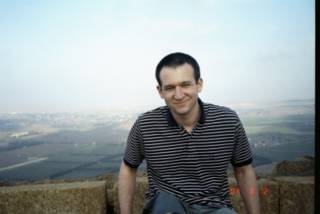Gershwin plays Gershwin
I'm sitting here listening to George Gershwin playing his own arrangements of his own songs for piano. Gershwin recorded eight of these arrangements, four from his show, "Oh, Kay!", and four from "Tip-Toes", all in 1926. I have them on a record with his recordings of Rhapsody in Blue with Paul Whiteman's Orchestra, his recording of his Three Preludes for Piano, and the first recording of "An American in Paris", Gershwin's tone tryptych of Paris in the 1920s. These recordings represent the balance of Gershwin's studio recordings.Musicians often flock to composer recordings for obvious reasons - they provide lessons in interpretation straight from the horse's mouth. Not so with Gershwin. Gershwin's recordings are very straight, flat really. His Preludes are delivered with little of the Tin Pan Alley style which makes them such a trip when they are played with feeling. Rhapsody in Blue suffers from a different problem; it's cut short by about half. The most likely is that RCA Victor wanted to get the recording on two sides of a record (a 12 inch 78 RPM record holds about 4 minutes and 30 seconds). But the recording is of great significance because it delivers Paul Whiteman's original jazz band, which will not sound like anything you've ever heard; the wa-wa effects of the trumpets and sound effects written into Ferde Grofe's orchestration come through with a certain freshness.
Gershwin's song arrangements are great, but according to Edward Jablonski's liner notes, they were recorded with the intention of being used as dance records, so they are metronomically monochromatic. And indeed, it's hard to believe Gershwin, the great improviser, would have played them this way were he playing them at some 1920s New York house party or in some Harlem nightclub.
My favorite recording of Rhapsody of Blue is by the pianist Ivan Davis with a jazz orchestra conducted by Maurice Peress. It is part of a 2-CD set entitled, "The Birth of Rhapsody in Blue: Paul Whiteman's Historic Aeolian Hall Concert of 1924". Rhapsody in Blue was premiered at this concert, which Whiteman subtitled, "A Experiment in Modern Music". The recording recreates the original performance. The Aeolian Hall concert was a kind of overview of American popular music written in the first quarter of the twentieth century. The concert featured a collection of songs played by Whiteman's orchestra, novelty pieces for piano, including some fantastic novelty piano works of Zez Confrey, and concluded with the Rhapsody, the 22nd piece on a program which must have at least three hours. (The Confrey pieces, incidentally, are played with great pizazz by Dick Hyman, the jazz piano.) The recording comes with extensive liner notes including a recreation of the original program from the concert. Unfortunately, the recording does not appear to be in print, but it is worth hunting down.


4 Comments:
I wonder how those works would have been interpreted by these people today, with the modern technology...
Irina
I don't think it would make a big difference. Gershwin probably would have recorded all of Rhapsody in Blue instead of half of it. It would sound a little better; you lose things like reverberation on old recordings. A crashing cymbal, for instance, will not sustain as it would if you heard it in a concert hall or on a modern recording. Gershwin actually recorded it twice; once in 1924 and again in 1927 because electrical recording was not used commercially until 1925. I have both; they are pretty much the same, though there's got to something more authentic about the 1924 recording because it was made so close to the premiere of the piece. The thing you get from the Gershwin/Whiteman recordings that you really don't get from modern recordings is that this piece is really more jazz than anything else. The musicians play like jazz musicians. I must say that the 1924 recording is probably the best acoustic (non-electrical) recording I've ever heard. These recordings are usually extremely limited sonically, but this one seems to have picked up just about everything.
I actually made a mistake by saying these were Gershwin's only studio recordings. These are Gershwin's only commerical studio recordings. There are a number of others from radio broadcasts that date from the 1930s, including performances of Gershwin's Second Rhapsody, and what I think is Gershwin's best performance on records, his recording of the "I Got Rhythm" Variations for piano and orchestra. There are also snippets of him playing his Concerto in F and directing performances of Porgy and Bess.
So there's no complete original recording of Rhapsody in Blue?
Irina
Not with Gershwin and Whiteman, no. The closest thing we have to what might be considered Gershwin's intentions is a recording by the pianist and social butterfly Oscar Levant, recorded in the 1940s. Levant was a close friend of Gershwin's. His recording is quite good in some respects, quite bad in others. It is an exciting account, but some of it is played so fast that it sounds clipped in some places. Levant sprints through the piece. There is a fine line between an exciting interpretation and a vulgar one.
Incidentally, I highly recommend a book Levant wrote in 1940, called, "A Smattering of Ignorance". In the book, Levant, writing like the socialite that he was, provides a vivid picture of the musical personalities of the 1930s and 1940s, with particular emphasis on Gershwin.
Post a Comment
<< Home